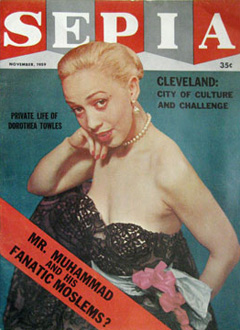Pictures of Progress
From the gruesome photograph of a lynching victim to the moving footage of Jackie Robinson’s first major league game, the images of the Civil Rights era motivated people to act, whether those actions were ignited by injustice or inspired by achievement. Yet there had never been a comprehensive examination of the ways images mattered throughout the struggle.
Six years ago, Maurice Berger, senior research scholar at the Center for Art, Design and Visual Culture (CADVC) at UMBC, set out to change that. With the backing of his colleagues at CADVC and two grants from the National Endowment for the Humanities, Berger began sorting through visual artifacts from the Civil Rights era to find those that best told the story of the decades-long struggle for Civil Rights.
“I have never felt more passionate about a project,” Berger said.
Now approximately 230 photographs, objects and video clips have come together to form For All the World to See: Visual Culture and the Struggle for Civil Rights, an exhibition co-organized by CADVC and the Smithsonian National Museum of African American History and Culture that will open at New York’s International Center for Photography on May 21.
“My father was a Civil Rights supporter before most white people even acknowledged the movement, so my initial inspiration comes from the dialogue I had with him as a young child,” said Berger. He has been studying and writing about race relations in many contexts—ranging from the historical to the personal—for over 25 years.
For All the World to See is the first exhibition to showcase the visual artifacts of the Civil Rights movement. During the era represented in the exhibition, from the late 1940s to the mid-1970s, images were becoming an important part of society: photo magazines grew popular and people increasingly got news from their televisions. These mediums not only reported on events, but reflected and influenced society’s perception of the movement with how they chose to present African Americans.
“I want viewers to see that efforts to combat racism and segregation during the Civil Rights era were waged not only with fiery speeches and nonviolent protests but also, significantly, with pictures, forever changing the way political movements fought for visibility and recognition,” said Berger.
During the time Berger spent working on the exhibition, he was also writing a book of the same name. The book, which was published this year by Yale University Press, provides a historical background for the images and provided the script for the exhibition. “The exhibition and the book influenced each other in innumerable ways,” said Berger.
The exhibition was designated a “We the People” project by the National Endowment for the Humanities. The goal of the “We the People” initiative is to support projects that explore significant events in America’s history and advance knowledge of the issues that define America.
For All the World to See will be on view at the International Center of Photography until September 12. Then, it will head to the Smithsonian Institution’s National Museum of American History from June to October of 2011. The exhibition’s last stop will be at UMBC, from September 2012 until January 2013.
(5/7/10)

